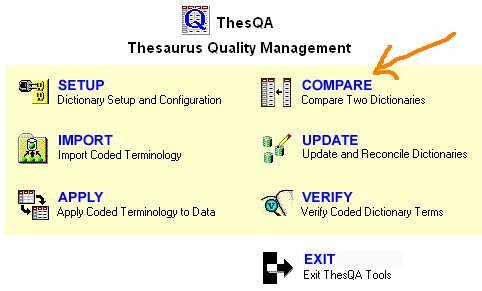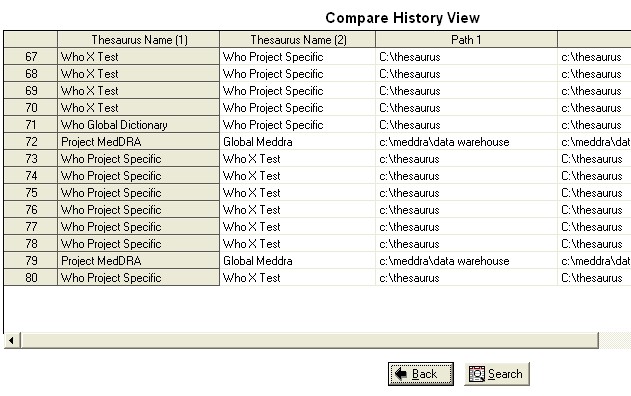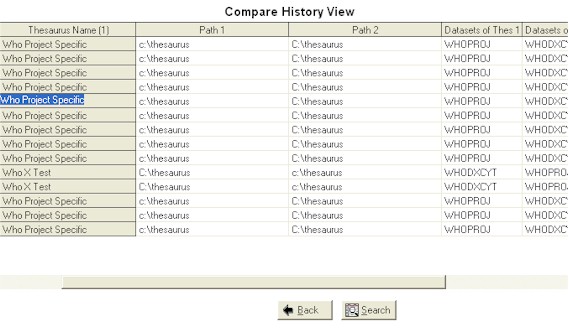|
Overview
One of the main tools in maintaining consistency and proper change
management over your dictionaries is the ability to perform
detailed comparisons. This can be applied both
to thesaurus or controlled coded terminology dictionaries. The differences
among the dictionaries shown through comparisons can reveal
discrepancies. Reconciling the discrepancies help you maintain optimal accuracy.
The comparison tools can be accessed from the main screen as shown here:

The main steps in performing
comparison for thesaurus dictionaries include:
The main steps in performing
comparison for coded terminology dictionaries include:
Selecting
Thesaurus Dictionaries
The first step in performing comparison is to select the thesaurus
dictionaries. ThesQA manages two types of dictionaries including
Thesaurus and Coded Terminologies. In this case, select the
dictionary type of "Thesaurus Dictionary".

There are two dictionaries that
will be compared. They are identified by their names as in "Dictionary
Name (1)" and "Dictionary Name (2)". The name is also used as
a unique identifier so you can use this as a way of selecting the
dictionary through the pull down menu. The other information
pertaining to the dictionary is displayed but is grayed out and not editable. These include:
- Path - Physical path to where
the dictionary information is stored
- Data - SAS dataset which stores
the dictionary information
- Data Label - The label of the
data documenting the description of the dictionary
- Keys - These are three unique
key fields that are used to merge and sort the data during comparisons
There are different categories of
thesaurus dictionaries including items like WHO Drug or MedDRA. The
selection of the first dictionary will alter the selection of the second dictionary since
you will only be able to select dictionaries from the same category.
You can also choose to preview the
data by clicking on the preview button next to the data entry. This
will display the first 100 observations of the contents of the dictionary
itself.
Performing Thesaurus Dictionary Comparisons
Once you have selected the two dictionaries from the COMPARE screen,
you can perform the comparisons by clicking on the OK button. This
will perform a sort and merge between the data of the dictionaries to find the differences. A report is then generated documenting
its findings with the following key areas:
- Compared Dictionary Details -
Document the attributes of two dictionaries including information such
as data set and keys fields.
- Mismatched Observations - Summarize
all the rows in the dictionary that has matching keys between the two
dictionaries.
- Detailed Summary - Details all
the rows that are matched and unmatched between the two dictionaries
Saving Thesaurus Dictionary Macro Code
The same selections that is made in the graphical user interface
can be expressed in macro named %tcompare.
You can select this through the "Save Code..." button. The
sample code that is generated would look like:
libname Thesqa "C:\Program Files\MetaXceed\ThesQA\data";
%tcompare(thes1 = Who Project Specific,
thes2 = Who X Test,
dictype = thesaurus);
This same program can then be
executed in batch mode to perform the same dictionary comparisons.
Reviewing Thesaurus Dictionary History
All the comparisons between
thesaurus dictionaries are retained in a complete audit trail. You
can view this history by clicking on the "History"
button.

This view presents all the
comparisons that have been done in chronological order. This includes
all the attributes of the comparisons including who has applied it and at
what time. A search can also be applied through the search button
from the compare history view button.

The search criteria is then
applied to all the fields in the history to derive a report capturing
all of its findings.
Selecting Coded Terminology Dictionaries
The first step in performing comparison is to select the coded
terminology dictionaries. ThesQA manages two types of dictionaries
including Thesaurus and Coded Terminologies. In this case, select
the dictionary type of "Coded Terminology".

There are two dictionaries that
will be compared. They are identified by their names as in
"Dictionary Name (1)" and "Dictionary Name
(2)". The name is also used as a unique identifier so you
can use this as a way of selecting the dictionary through the pull down
menu. The other information pertaining to the dictionary.
These attributes include:
- Coded Name - A unique
identifier assigned to the set of coded terms
- Coded Value - A specific coded
term that is associated to a coded name
- Decoded Value - A specific
decoded value associated with the coded value
The selection of the dictionary
name will refresh the list of attributes pertaining to the coded
terminologies. Besides selecting the dictionary name, you must also
select one specific coded name for each dictionary to be compared.
This is accomplished by simply clicking on one of the names.
Performing Coded Terminology Comparisons
Once you have selected the coded name for both source and
destination dictionaries, you can begin performing the comparison by
selecting on the OK button. A report will then be generated which
includes the following information:
- Matching Terms in Both
Dictionaries - This report reveals all the codes and decodes that have
matches between the coded and decoded terms.
- Mismatch Terms found in Source
but not found in Destination - This report displays all terms in the
source that were not found in the destination
- Mismatch Terms found in
Destination but not in Source - This report displays all terms in the
destination that were not found in the source
Saving Coded Terminology Macro Code
The same selections that is made in the graphical user interface
can be expressed in macro named %tcompare.
You can select this through the "Save Code..." button. The
sample code that is generated would look like:
libname Thesqa "C:\mypath\data";
%tcompare(thes1 = CDISC 3.1.1 Controlled Terminology,
thes2 = Sample Coded Terms,
dictype = coded terms);
This same program can then be
executed in batch mode to perform the same dictionary comparisons.
Reviewing Coded Terminology History
An audit trail of the comparisons
between dictionaries is kept in the history. This history can be
reviewed and searched through the "History" button. A
history view looks like the following:

An audit trail captures all the
terms that have been applied including when and who has applied it.
This information can be searched by any field. The search criteria
in which you specified will be applied to all the fields captured in the
audit history.
|